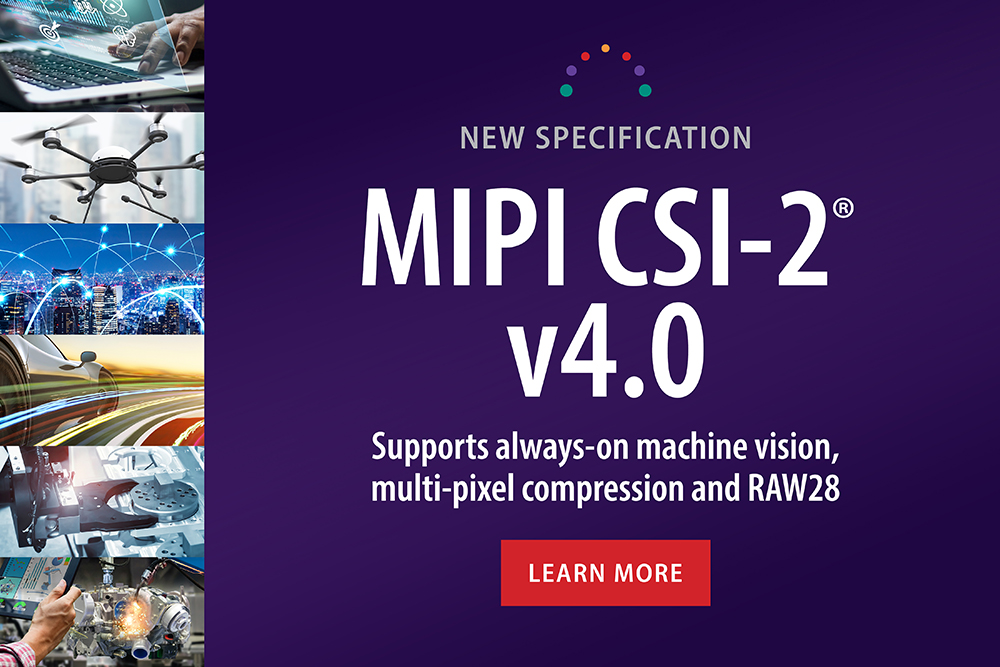3 min read
Major Update to MIPI CSI-2 Camera Specification Enables Next Generation of Always On, Low Power, Machine Vision Applications
![]() MIPI Alliance
:
08 February, 2022
MIPI Alliance
:
08 February, 2022

- News & Events
- News
- Press Releases
Version 4.0 of the popular embedded image sensor interface adds Always-On Sentinel Conduit for environmental monitoring, multi-pixel compression and RAW28 color depth for safety-critical applications
PISCATAWAY, N.J., February 8, 2022—The MIPI Alliance, an international organization that develops interface specifications for mobile and mobile-influenced industries, today announced a significant update to its MIPI Camera Serial Interface 2 (MIPI CSI-2) interface to enable advanced machine-vision applications in multiple application spaces, such as mobile, augmented and virtual reality, drones, the Internet of Things (IoT), medical devices, industrial systems, automobiles, and client devices such as tablets, notebooks and all-in-ones.
Building on the machine awareness capabilities introduced in MIPI CSI-2 v3.0, v4.0 adds an advanced always-on imaging solution that operates over as few as two wires to lower cost and complexity for ultra-low-power machine vision applications. CSI-2 v4.0 also adds multi-pixel compression for the latest generation of advanced image sensors and RAW28 color depth to provide unprecedented image quality and superior signal-to-noise (SNR) ratio.
Originally introduced in 2005, MIPI CSI-2 has become the world’s most widely implemented embedded camera and imaging interface. As the de facto high-speed protocol for the transmission of still and video images from image sensors to application processors, it supports a broad range of use cases that require high performance, low power and low electromagnetic interference (EMI). Typically implemented for shorter-reach applications on either a MIPI C-PHY or MIPI D-PHY physical-layer interface, v4.0 is the first to support transmission of CSI-2 image frames over the low-cost, low-pin-count MIPI I3C/I3C Basic two-wire interface. CSI-2 can also be implemented over the MIPI A-PHY long-reach SerDes interface (up to 15m) for use in such applications as automotive advanced driver-assistance systems (ADAS) and in-vehicle infotainment, and industrial IoT.
New features within the specification include:
- Always-On Sentinel Conduit (AOSC) — Enables always-on machine vision systems in which combinations of ultra-low-power image sensors and video signal processors (VSPs) can continuously monitor their surrounding environments and then wake their higher-power, host CPUs only when significant events happen. (Typically, the VSP will be either a separate device or integrated with the host CPU within a larger SoC.) Example uses include laptop/tablet-based face monitoring, video surveillance, and vision-based vehicle safety applications. AOSC enables image frames to be economically streamed from an image sensor to a VSP over a low-power MIPI I3C bus in a highly efficient manner, with scaling options to add extra I3C lanes and bandwidth as defined by the I3C specification.
- Multi-Pixel Compression (MPC) — Provides optimized pixel compression for the latest generation of Tetra-Cell and Nona-Cell image sensors with multi-pixel color filter arrays (CFAs). The MPC feature helps alleviate the high bandwidth demands of these sensors by compressing both multi-pixel and standard Bayer CFA images more efficiently and with potentially higher quality than current methods. Reference code has also been made available to help integrators evaluate the algorithm and verify their implementations.
- RAW28 pixel encoding — Supports the next generation of high-dynamic-range automotive image sensors for applications such as those required for ADAS and other safety-critical applications.
CSI-2 v4.0 is backward compatible with all previous versions of the MIPI specification.
“The innovations delivered within MIPI CSI-2 provide a scalable foundation upon which next-generation artificial intelligence and machine-vision systems will enhance human-device interaction,” said Joel Huloux, chairman of MIPI Alliance. “With its new features, v4.0 vastly expands the range of application, from simplified, low-power environmental monitoring, to compression and superior image quality for high-performance, safety-critical applications."
MIPI CSI-2 v4.0 is available to MIPI Alliance members and can be downloaded from the member portal on the MIPI Alliance website. More information about each of these new features can be found in the "MIPI CSI-2 v4.0 Panel Discussion with the MIPI Camera Working Group" presentation at the September 2021 MIPI Developers Conference (DevCon).
To keep up with MIPI Alliance, subscribe to the MIPI blog and stay connected by following MIPI on Twitter, LinkedIn, Facebook and YouTube.
About MIPI Alliance
MIPI Alliance (MIPI) develops interface specifications for mobile and mobile-influenced industries. There is at least one MIPI specification in every smartphone manufactured today. Founded in 2003, the organization has over 350 member companies worldwide and more than 15 active working groups delivering specifications within the mobile ecosystem. Members of the organization include handset manufacturers, device OEMs, software providers, semiconductor companies, application processor developers, IP tool providers, automotive OEMs and Tier 1 suppliers, and test and test equipment companies, as well as camera, tablet and laptop manufacturers. For more information, please visit www.mipi.org.
MIPI®, CSI-2® and I3C® are registered trademarks owned by MIPI Alliance. A-PHYSM, C-PHYSM, D-PHYSM and I3C BasicSM are service marks of MIPI Alliance.






